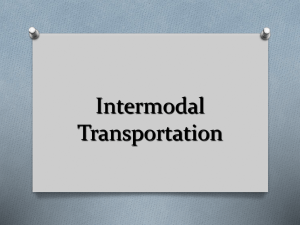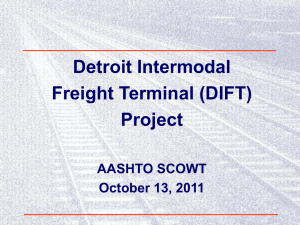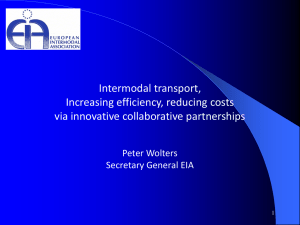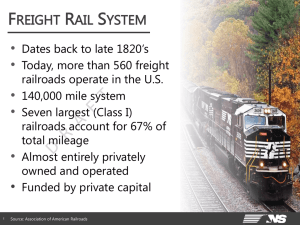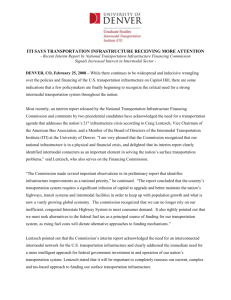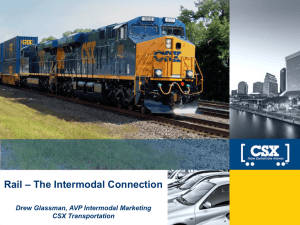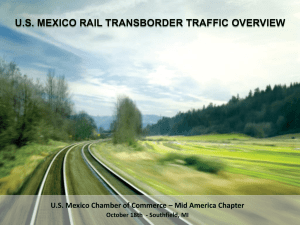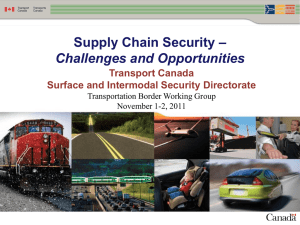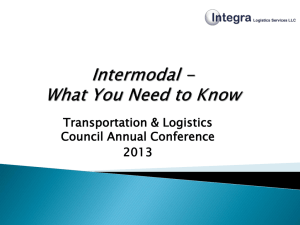A Brief Overview of Intermodal Transportation
advertisement
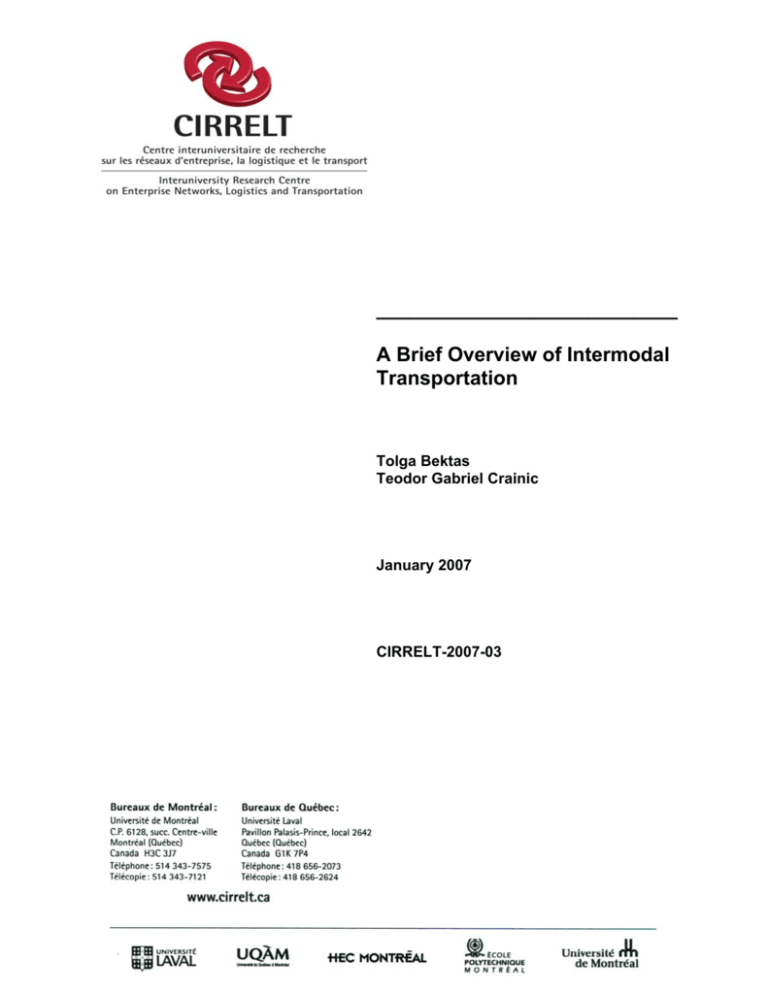
___________________________
A Brief Overview of Intermodal
Transportation
Tolga Bektas
Teodor Gabriel Crainic
January 2007
CIRRELT-2007-03
A Brief Overview of Intermodal Transportation
Tolga Bektas1, Teodor Gabriel Crainic1,*
1
Interuniversity Research Centre on Enterprise Networks, Logistics and Transportation
(CIRRELT), Université de Montréal, C.P. 6128, succursale Centre-ville, Montréal, Canada
H3C 3J7 and Chaire de recherche industrielle du CRSNG en management logistique, ESG,
Université du Québec à Montréal, C.P. 8888, succursale Centre-ville, Montréal, Canada H3C 3P8
Abstract. This paper focuses on Intermodal Freight Transportation broadly defined as a
chain made up of several transportation modes that are more or less coordinated and
interact in intermodal terminals to ensure door-to-door service. The goal of the chapter is
to present intermodal transportation from both the supplier and the carrier perspectives,
and identify important issues and challenges in designing, planning, and operating
intermodal transportation networks, focusing on modeling and the contributions of
operations research to the field.
Keywords. Intermodal transportation, freight transportation, operations research
Acknowledgements. Partial funding for this project has been provided by the Natural Sciences
and Engineering Research Council of Canada (NSERC) through its Discovery Grants and Chairs
and Faculty Support programs.
Results and views expressed in this publication are the sole responsibility of the authors and do not
necessarily reflect those of CIRRELT.
Les résultats et opinions contenus dans cette publication ne reflètent pas nécessairement la position du
CIRRELT et n'engagent pas sa responsabilité.
_____________________________
* Corresponding author: Teodor-Gabriel.Crainic@cirrelt.ca
Dépôt légal – Bibliothèque nationale du Québec,
Bibliothèque nationale du Canada, 2007
© Copyright Bektas, Crainic and CIRRELT, 2007
A Brief Overview of Intermodal Transportation
I. Introduction
In today’s world, intermodal transportation forms the backbone of world trade. Contrary to
conventional transportation systems in which different modes of transportation operate in an
independent manner, intermodal transportation aims at integrating various modes and services of
transportation to improve the efficiency of the whole distribution process. Parallel to the growth
in the amount of transported freight and the changing requirements of integrated value (supply)
chains, intermodal transportation exhibits significant growth. According to the U.S. Department
of Transportation (2006), the value of the multimodal shipments, including parcel, postal service,
courier, truck-and-rail, truck-and-water, and rail-and-water increased from about $662 billion to
about $1.1 trillion in a period of nine years (1993 to 2003).
Major players in intermodal transportation networks are shippers, who generate the
demand for transportation, carriers, who supply the transportation services for moving the
demand, and the intermodal network itself composed of multimodal services and terminals. The
interactions of these players and their individual behavior, expectations, and often conflicting
requirements determine the performance of intermodal transportation systems. The goal of this
chapter is therefore to be informative on intermodal transportation, from both the supplier and
the carrier perspective, identify important issues and challenges in designing and operating
intermodal transportation networks, and point out major operations research contributions to the
field. A more in-depth discussion of these topics may be found in, for example, Crainic and Kim
(2007), Macharis and Bontekoning (2004), and Sussman (2000).
The chapter is structured as follows. Section II presents the basics on intermodal
transportation, with an emphasis on its foremost components: containers, carriers, and shippers.
We then discuss, in Sections III and IV, respectively, the major issues and challenges of
intermodalism from the shippers and carriers perspective. Section V provides a brief description
of intermodal terminals and the operations performed therein. Section VI is dedicated to the case
of rail intermodal transportation, as an illustration of the main discussion.
II. Intermodal Transportation
Many transportation systems are multimodal, that is, the infrastructure supports various
transportation modes, such as truck, rail, air, and ocean/river navigation, carriers operating and
offering transportation services on these modes. Then, broadly defined, intermodal
CIRRELT-2007-03
1
A Brief Overview of Intermodal Transportation
transportation refers to the transportation of people or freight from their origin to their
destination by a sequence of at least two transportation modes. Transfers from one mode to the
other are performed at intermodal terminals, which may be a sea port or an in-land terminal, e.g.,
rail yards, river ports, airports, etc. Although both people and freight can be transported using an
intermodal chain, in this chapter, we concentrate on the latter.
The fundamental idea of intermodal transportation is to consolidate loads for efficient
long-haul transportation (e.g., by rail or large ocean vessels), while taking advantage of the
efficiency of local pick-up and delivery operations by truck. This explains the importance of
container-based transportation. Freight intermodal transportation is indeed often equated to
moving containers over long distances through multimodal chains. Intermodal transportation is
not restricted, however, to containers and intercontinental exchanges. For instance, the
transportation of express and regular mail is intermodal, involving air and land long-haul
transportation by rail or truck, as well as local pick up and delivery operations by truck (Crainic
and Kim 2007). In this paper, we focus on container-based transportation.
An intermodal transportation chain is illustrated in Figure 1. In this example, loaded
containers leave the shipper’s facilities by truck to a rail yard, where they are consolidated into a
train and sent to another rail yard. Trucks are again used to transport the containers from this rail
yard to the sea container terminal. This last operation may not be necessary if the sea container
terminal has an interface to the rail network, in which case freight is transferred directly from
one mode to the other. Containers are then transported to a port on another continent by ocean
shipping, from where they leave by either trucking or rail (or both) to their destinations.
Figure 1. An intermodal transportation network
CIRRELT-2007-03
2
A Brief Overview of Intermodal Transportation
II.1 Containers
A container, as defined by the European Conference of Ministers of Transport (2001), is a
“generic term for a box to carry freight, strong enough for repeated use, usually stackable and
fitted with devices for transfer between modes”. The fact that the standards on container
dimensions were established very early also explains its popularity. A standard container is the
20-foot box, which is 20 feet long, 8'6" feet high and 8 feet wide. This is refereed to as a Twentyfoot Equivalent Unit (TEU). However, the widely used container size is the 40-foot box (a
number of longer boxes are sometimes used for internal transport in North America). Containers
are either made of steel or aluminum, the former being used for maritime transport and the latter
for domestic transport.
Intermodal transportation relies heavily on containerization due to its numerous
advantages. First, containerization offers safety by significantly reducing loss and damage, since
the contents of a container cannot easily be modified unless except at origin or destination. It is
worth mentioning in this respect that the safety level of container transportation is currently
being significantly increased by electronic sealing and monitoring to address preoccupations
with terrorist treats, illegal immigration, and smuggling. Second, due to its standard structure,
transfer operations at terminals are fast and performed with a minimal amount of effort. This
results in reduced cargo handling, and thus a speed-up of operations not only at the terminals, but
through the whole transport chain. Third, containers are flexible enough to enable the transport
of products of various types and dimensions. Fourth, containerization enables a better
management of the transported goods. Due to these reasons, the use of containers significantly
decreases transport costs.
Containerization has had a noteworthy impact on both land transportation and the way
terminals are structured. An example for the former can be seen in rail transportation, where
special services have been established by North-American railways, enabling container
transportation by long, double-stack trains. As for the latter, ports and container terminals have
either been built or undergone major revisions to accommodate continuously larger container
ships and efficiently perform the loading, unloading, and transfer operations. Container terminal
equipment and operating procedures are continuously enhanced to improve productivity and
compete, in terms of cost and time, with the other ports in attracting ocean shipping lines.
CIRRELT-2007-03
3
A Brief Overview of Intermodal Transportation
II.2 Carriers
In an intermodal chain, carriers may either provide a customized service, where the vehicle (or
convoy) is dedicated exclusively to a particular customer, or operate on the basis of
consolidation, where each vehicle moves freight for different customers with possibly different
origins and destinations.
Full-load trucking is a classic example of customized transportation. Upon the call of a
customer, the truck is assigned to the task by the dispatcher. The truck then travels to the
customer location, is loaded, and then moves to the destination, where it is unloaded. Following
this, the driver is either assigned a new task by the dispatcher, kept waiting until a new demand
appears in the near future, or repositioned to a location where a load exists or is expected to be
available about the arrival time. The advantages of full-load trucking come from its flexibility in
adapting to a highly dynamic environment and uncertain future demands, offering reliability in
service and low tariffs compared to other modes of transportation. The fill efficiency of full-load
trucking is achieved through the implementation of resource management and allocation
strategies that seek to make the best use of the available resources, while maximizing the volume
of demand satisfied and the associated profits (Powell and Topaloglu, 2005, Powell, BouzaïeneAyari, and Simaõ, 2007). Customized services are also offered, for example, by charted sea or
river vessels and planes.
In many cases, however, trade-offs between volume and frequency of shipping, along
with the cost of transportation, render customized services impractical. Consolidation, in such
situations, turn out to be an attractive alternative. Freight consolidation transportation is
performed by Less-Than-Truckload (LTL) motor carriers, railways, ocean shipping lines, regular
and express postal services, etc. A consolidation transportation system is structured as a huband-spoke network, where shipments for a number of origin-destination points may be
transferred via intermediate consolidation facilities, or hubs, such as airports, seaport container
terminals, rail yards, truck break-bulk terminals, and intermodal platforms. An example of such a
network with three hubs and seven regional terminals (origin and destination points for demand)
is illustrated in Figure 2. In hub-and-spoke networks, low-volume demands are first moved from
their origins to a hub where the traffic is sorted (classified) and grouped (consolidated). The
aggregated traffic is then moved in between hubs by high frequency and high capacity services.
Loads are then transferred to their destination points from the hubs by lower frequency services
often utilizing smaller vehicles. When the level of demand is sufficiently high, direct services
CIRRELT-2007-03
4
A Brief Overview of Intermodal Transportation
may be run between a hub and a regional terminal. Although a hub-and-spoke network structure
results in a more efficient utilization of resources and lower costs for shippers, it also incurs a
higher amount of delays and a lower reliability due to longer routes and the additional operations
performed at terminals. The planning methodologies evoked at Section 4 aim to address these
issues.
Figure 2. A hub-and-spoke network
Land consolidation transportation services are offered by LTL motor carriers and
railways. The flexibility, high frequency, and low cost of trucking transportation resulted in a
high market share of freight transportation being captured by this mode. This situation, which
may be observed world-wide, resulted in very large truck flows and road congestion, and
contributes significantly to the high level of pollutant emissions attributed to the transportation
sector. The trend is slowly changing, however. On the one hand, recent policy measures,
particularly in the European community, target the mode change from road-based to intermodal.
On the other hand, the continuous and significant increase in container-based international
traffic, which generates large flows of containers that need to be moved over long distances,
favors rail (and, in a smaller measure, river) based transportation.
Railways have risen to the challenge by proposing new types of services and enhanced
performances. Thus, North-American railways have created intermodal subdivisions which
operate so-called “land-bridges” providing efficient container transportation by long, doublestack trains between the East and the West coasts and between these ports and the industrial core
CIRRELT-2007-03
5
A Brief Overview of Intermodal Transportation
of the continent (so-called “mini” land-bridges). New container and trailer-dedicated shuttle-train
networks are being created within the European Community. These initiatives have succeeded.
Thus, intermodal transportation is the fastest growing part of railroad traffic. Thus, for example,
in a period of only 2 years, from 2003 to 2005, the amount of rail intermodal traffic in the U.S.
grew from 7.33 million to 8.71 million containers (Association of American Railroads, 2006).
Note that the 8.71 million containers transported by rail in U.S. in 2005 represent about 75% of
the total intermodal units moved in that year, the remaining 25% being trailers. In Canada, there
is a similar trend in the number of intermodal carloads, which grew by 336 000 or 77.5% during
the past decade. This number represents 26.3% of the industry’s overall growth in originated
carloads during this period (The Railway Association of Canada, 2006). Section 6 discusses rail
intermodal transportation in some more depth.
Maritime and air-based modes are used for the intercontinental legs of intermodal
transportation. Heavily container-based, the former provide the backbone of non-bulk
international trade. Efficiency reasons result in continuously larger container vessels being
commissioned for inter-continental movements. The operation of such ships, which cannot pass
through the Panama Canal, should not stop too frequently, and cannot even berth in most ports,
has had a number of important consequences. In particular, maritime and land transportation
routes have been modified through, for example, the creation of the North-American landbridges and the introduction of a “new” link into the intermodal chain: super-ships stop at a small
number of major seaports and containers are transferred to smaller ships for distribution to
various smaller ports. For maritime transportation, variations in travel times are larger, and travel
and loading/unloading times are longer, compared to that of most land-based trips. As for the air
mode, although being increasingly used for intermodal transport, its relatively higher costs still
make it interesting mostly for high-value or urgent deliveries.
All consolidation-based transportation modes involved in intermodal transportation must
provide efficient, reliable, and cost-effective services. Comparatively, railways face the biggest
challenge, however, in competing with trucking to provide shippers the level and quality of
service they require for their land long-haul transportation needs. Sections IV and VI discuss
these issues.
CIRRELT-2007-03
6
A Brief Overview of Intermodal Transportation
II. 3 Shippers
Shippers generate the demand for transportation. Defining its logistics strategy represents a
complex decision process, and the choice of the transport mode is only a part of this whole
strategy. This process is generally assumed to have a three-level decision structure, composed of
long, medium and short term decision (Bolis and Maggi, 2003). In the long run, shippers define
their logistics strategies in terms of their customer network and production. Medium-term plans
include decisions as to inventories at production, warehousing, and distribution facilities,
frequency and amount of shipping, flexibility of service, etc. Finally, the shipper decides, at the
short-term level, the attributes of the services required for its shipments, such as maximum rates,
transport time, reliability and safety.
When such decisions are made, shippers consider the availability and the characteristics
of the services offered on the market by carriers and intermediaries such as freight brokers and
third-party logistics providers. These decisions are based on several factors detailed in the
following section. It’s worth mentioning, however, that in many cases shipper decisions have a
greater importance for the outcome of the service rather than the way it is delivered.
III. Shipper Perspectives on Intermodal Transportation
Although intermodal networks are formed as combinations of individual transportation modes
and transfer facilities, a shipper perceives it as a single integrated service. Shippers therefore
expect intermodal services to behave similarly to unimodal services, especially in terms of speed,
reliability, and availability.
The shipper's decision to use a particular transportation mode is generally based on
several criteria. A number of studies mostly based on surveys and data analyses have been
conducted to identify the specific service characteristics often deemed important in the shipper
decision process. McGinnis (1990) identified six factors that affect the shipper’s decision in
choosing a specific transportation mode, namely 1) freight rates (including cost and charges), 2)
reliability (delivery time), 3) transit times (time-in-transit, speed, delivery time), 4) over, short
and damaged shipments (loss, damage, claims processing, and tracing), 5) shipper market
considerations (customer service, user satisfaction, market competitiveness, market influences),
and 6) carrier considerations (availability, capability, reputation, special equipment). Amongst
these, shippers were observed to place more emphasis on overall service than cost, although
freight rates still had a significant importance. Five years later, in an update to McGinnis' study,
CIRRELT-2007-03
7
A Brief Overview of Intermodal Transportation
Murphy and Hall (1995) observed that reliability, as opposed to cost or any other factor, had
more influence on the U.S. shipper decisions.
As important as the shipper's choice of transportation modes may be, shipper perception
of modes and services is believed to have a higher impact on the overall decision process.
Quoting from Evers et al. (1996), “shippers decide on the mode of transportation and specific
carrier only after they have formed perceptions of the alternative services. They compare their
perceptions, and possibly other information, with criteria they have developed. Then, they use a
decision-making process to choose the transportation method that best meets their established
criteria”. Hence, shipper perception is a central input component to the decision making process
in mode selection.
In a study conducted to identify the determinants of shipper perceptions of modes, Evers
et al. (1996) proposed six factors: 1) timeliness, 2) availability, 3) firm contract, 4) suitability, 5)
restitution, and 6) cost, the first two being observed to have a greater effect than the others. Thus,
the more a carrier focuses on improving shipper’s perceptions of these six factors, the more
likely it is for it to be used. Extending their analysis to an individual carrier level, Evers and
Johnson (2000) found that the future collaboration of a shipper with an intermodal service is
affected by the shipper’s satisfaction with, and ability to replace, the carrier. They identified that
determinants of shipper’s perceptions at the carrier level were communication, quality of
customer service, consistent delivery, transit times, and competitive rates, with the first two
factors being the most important drivers of the overall perception. Although these results do
confirm what is expected of a carrier, it is interesting to see that the perception of modes may be
different from that of carriers. More specifically, the two chief factors influencing the overall
perception for modes, namely timeliness and availability, are replaced by communication and
customer service for the individual carriers.
Studies performed in the early 1990’s revealed that shippers have varying perceptions of
alternative transportation modes. In general, shippers were found to perceive truck transportation
best, followed by intermodal (rail-truck) transportation, and rail transportation. Prior research
indicates that perceptions of railroad service have improved since deregulation in 1980, both in
terms of rates and service. More recent research shows that price, time, and reliability are
important factors in the decision process, but, frequency and flexibility also emerge as significant
decision factors when firms operate in a JIT context. Empirical evidence exists, on the other
CIRRELT-2007-03
8
A Brief Overview of Intermodal Transportation
hand, as to the fact that, in Europe, rail has no acceptance problems but that of service quality
(Bolis and Maggi, 2003).
Shipper perceptions, influenced by past experiences, expectations, common knowledge,
carrier advertising, modal image, and misinformation (Evers et al., 1996), may not always reflect
the real situation. After all, a shipper's perception of a mode or an individual carrier is a tentative
view. This, however, may be altered through marketing efforts by the carrier. Carriers thus
should strive to ensure that the shipper's perception is in line with reality as much as possible as
such efforts can be beneficial, in terms of increased usage of their service. Failure to put forth
such efforts may easily place the carrier at a disadvantage with respect to its competitors.
IV. Carrier Perspective on Intermodal Transportation
Carriers face a number of issues and challenges in providing an efficient and cost effective
service to the customer, which may be examined according to classical categorization of
planning decisions, namely strategic (long term), tactical (medium term), and operational (short
term) level of planning and management of operations. We briefly address these issues in this
section by focusing on consolidation-based carrier cases. This choice is motivated by the
complexity of the planning issues in this context and on the fact that intermodal transportation
forms a consolidation-based system. For a more in-depth treatment, one may consult the reviews
of Christiansen et al. (2005, 2007), Cordeau et al. (1998), and Crainic (2003), Crainic and Kim
(2007), Crainic and Laporte (1997).
IV.1 System Design
At the strategic level, the carrier is concerned with the design of the physical infrastructure
network involving decisions as to the number and location of terminals (e.g., consolidation
terminals, rail yards, intermodal platforms), the type and quantity of equipment (e.g., cranes) that
will be installed at each facility, the type of lines or capacity to add or abandon, the customer
zones to serve directly, etc. The term system design encompasses issues pertinent to strategic
level decisions. It is often the case that such decisions are made by evaluating alternatives using
network models for tactical or operational planning of transportation activities. When specific
models are developed for strategic planning issues, these usually take the form of static and
deterministic location formulations addressing issues related to the location of consolidation or
hub terminals and the routing of demand from its origin to its destination terminals.
CIRRELT-2007-03
9
A Brief Overview of Intermodal Transportation
To illustrate the methodological approaches proposed to address strategic planning issues
for consolidation-based carriers, we examine the issue of determining the sub structure of such a
system. This problem consists in determining the locations of the hubs on a given network, the
assignment of local terminals to the hubs that are established, and the routing of loads of each
demand through the resulting network. In its most basic form, the problem is addressed by a
multi-commodity hub-location formulation, assuming that all traffic passes through two hubs on
its route from its origin to its destination. In this simple formulation, it is assumed that there can
be no direct transport between non-hub terminals, based on the hypothesis that inter-hub
transportation is more efficient due to consolidation. Furthermore one also assumes that there are
neither capacity restrictions on hubs, nor fixed costs associated with establishing a link between
a regional and a consolidation terminal.
The problem is modeled on a directed network G = (N, A), with N as the set of nodes (or
vertices) and A is the set of arcs (or links). Nodes are identified as origins (set O), destination (set
D), and hubs or consolidation nodes (set H; sets O, N, and H are not necessarily disjoint). The set
of commodities (types of containers) that move through the network are represented by the set P.
The amount of commodity p ∈ P to be transported from origin terminal i ∈ O to destination
terminal k ∈ D is denoted by d ikp . There are three decision variables. y j is a binary variable
equal to 1 if a consolidation terminal is located at site j and 0, otherwise. yij is a binary variable
p
equal to 1 if terminal i is linked to hub j and 0, otherwise. Finally, variable xijlk
denotes the
amount of flow for commodity p with origin i, destination k, passing through terminals j and l in
the given order. The following formulation then solves the aforementioned network design
problem with exactly M hubs are installed in the network, where cijp , clkp , and c jlp stand for the unit
transportation costs between origin terminals and hubs, hubs and destination terminals, and interhubs, respectively.
Minimize
⎧⎪
∑ ⎨∑ ∑ c
p∈P
⎩⎪ i∈O
subject to
j∈H
∑y
j∈H
p
ij
j
= M,
∑∑ x
j∈H l∈H
CIRRELT-2007-03
⎫
⎛
⎛
⎛
p ⎞
p
p ⎞
p
p ⎞⎪
yij ⎜ ∑ ∑ xijlk
⎟ + ∑ ∑ clk ylk ⎜ ∑ ∑ xijlk ⎟ + ∑ ∑ c jl yij ykl ⎜ ∑ ∑ xijlk ⎟ ⎬
⎝ l∈H k∈D
⎠ l∈H k∈D
⎝ i∈O k∈D
⎠ ⎭⎪
⎝ i∈O j∈H
⎠ j∈H l∈H
p
ijlk
(4.1)
= d ikp
i ∈ O, k ∈ D, p ∈ P,
10
(4.2)
A Brief Overview of Intermodal Transportation
y ij ≤ y j
i ∈ O, j ∈ H,
(4.3)
y kl ≤ y l
k ∈ D, l ∈ H,
(4.4)
p
xijlk
≤ d ikp y j
i ∈ O, k ∈ D, j, l ∈ H, p ∈ P,
(4.5)
p
xijlk
≤ d ikp yl
i ∈ O, k ∈ D, j, l ∈ H, p ∈ P,
(4.6)
y j ∈ {0,1}
j ∈ H,
(4.7)
yij ∈ {0,1}
i ∈ O, j ∈ H,
(4.8)
p
xijlk
≥0
i ∈ O, k ∈ D, j, l ∈ H, p ∈ P.
(4.9)
The objective function of the formulation minimizes the total transportation cost of the
system. Constraints (4.1) state that exactly M hubs should be located in the network. To ensure
that the demands are satisfied, constraints (4.2) are used. Constraints (4.3) and (4.4) guarantee
that a terminal is assigned to a hub only if the hub is established. Constraints (4.6) and (4.7)
serve a similar purpose in terms of routing the flows using only selected hubs.
The previous quadratic formulation was first introduced by O’Kelly (1987), while,
Campbell (1994) proposed its first linearization. Both formulations are difficult, as are more
complex models that include capacities, fixed costs to open facilities, link terminals to hubs, or
establish transportation connections, more complex load routing patterns, etc. Consequently,
although several contributions have been made relative to the analysis of hub location problems
and the development of solution procedures, this is still an active and interesting field of research
(see, e.g., the surveys of Campbell et al., 2000 and Ebery et al., 2000).
IV.2 Service Network Design
Designing the service network of a consolidation-based carrier refers to constructing the
transportation (or load) plan to serve the demand, while at the same time operating the system in
an efficient and profitable manner. These plans are built given an existing physical infrastructure
and a fixed amount of resources, as determined during the system design phase.
Service network design is concerned with the planning of operations related to the
selection, routing, and scheduling of services, the consolidation of activities at terminals, and the
routing of freight of each particular demand through the physical and service network of the
CIRRELT-2007-03
11
A Brief Overview of Intermodal Transportation
company. These activities are a part of the tactical planning at a system-wide level. The two
main types of decisions that are considered in service network design are to determine the
service network and the routing of demand. The former refers to selecting the routes,
characterized by origin-destination nodes, intermediate stops and the physical route, and
attributes, such as the frequency or the schedule, of each service. The latter is concerned with the
itineraries that specify how to move the flow of each demand, including the services and
terminals used, the operations performed in these terminals, etc. Although minimization of total
operating cost is the main criterion of the service network design objective, improving the
quality of service measured by its speed, flexibility, and reliability is increasingly being
considered as an additional component of this goal. Service performance measures modeled, in
most cases, by delays incurred by freight and vehicles or by the respect of predefined
performance targets, are then added to the objective function of the network optimization
formulation. The resulting generalized-cost function thus captures the tradeoffs between
operating costs and service quality. For further details, the reader is referred to Crainic (2000)
and Crainic and Kim (2007).
Formulations for service network design either assume that the demand does not vary
during the planning period (static formulations) or explicitly consider the distribution of demand
as well as the service departures and the movements of services and loads in time (timedependent formulations). In both cases, however, modeling efforts take the form of deterministic,
fixed cost, capacitated, multicommodity network design formulations. To illustrate such
approaches, we provide here the multimodal multicommodity path-flow service network design
modeling framework proposed by Crainic and Rousseau (1986; see Powell and Sheffi, 1989 for a
complementary formulation) for the static case.
In this formulation, the service network, defined on a graph G = (N, A) representing the
physical infrastructure of the system, specifies the transportation services that could be offered.
Each service s ∈ S is characterized by its 1) mode, which may represent either a specific
transportation mode (e.g., rail and truck services may belong to the same service network), or a
particular combination of traction and service type; 2) route, defined as a path in A, from its
origin terminal to its destination terminal, with intermediary terminals where the service stops
and work may be performed; 3) capacity, which may be measured in load weight or volume,
number of containers, number of vehicles (when convoys are used to move several vehicles
simultaneously), or a combination thereof; 4) service class that indicates characteristics such as
CIRRELT-2007-03
12
A Brief Overview of Intermodal Transportation
preferred traffic or restrictions, speed and priority, etc. To design the service network thus means
to decide what service to include in the transportation plan such that the demands and the
objectives of the carrier are satisfied. When a service is operated repeatedly during the planning
period, the design must also determine the frequency of each service.
A commodity p ∈ P is defined as a triplet (origin, destination, type of product or vehicle)
and traffic moves according to itineraries. An itinerary l ∈ Lp for commodity p specifies the
service path used to move (part of) the corresponding demand: the origin and destination
terminals, the intermediary terminals where operations (e.g., consolidation and transfer) are to be
performed, and the sequence of services between each pair of consecutive terminals where work
is performed. The demand for product p is denoted by dp. Flow routing decisions are then
represented by decision variables hlp indicating the volume of product p moved by using its
itinerary l ∈ Lp. Service frequency decision variables ys, s ∈ S, define the level of service offered,
i.e., how often each service is run during the planning period. Let Fs(y) denote the total cost of
operating service s, and Clp ( y, h) denote the total cost of moving (part of) product p demand by
using its itinerary l. Further, a penalty term θ (y,h) is included in the objective function capturing
various relations and restrictions, such as the limited service or infrastructure capacity. The
following formulation can then be used for the service network design problem:
Minimize
∑ F ( y) + ∑ ∑ C
s
s∈S
subject to
∑h
l∈L p
p
l
p∈P l∈L p
= dp
p
l
( y , h) + θ ( y , h)
p ∈ P,
( ys , xlp ) ∈ Χ
s ∈ S, l ∈ Lp, p ∈ P,
y s ≥ 0 and integer
s ∈ S,
hlp ≥ 0
l ∈ Lp, p ∈ P,
where ( ys , xlp ) ∈ Χ stand for the classical linking constraints (i.e., no flow may use an unselected
service) as well as additional constraints reflecting particular characteristics, requirements, and
policies of the particular firm (e.g., particular routing or load-to-service assignment rules). The
objective function of this formulation describes a generic cost structure, flexible enough to
accommodate various productivity measures related to terminal and transportation operations. As
an example, one may consider service capacity restrictions as utilization targets, which may be
CIRRELT-2007-03
13
A Brief Overview of Intermodal Transportation
allowed to be violated at the expense of additional penalty costs. The last component of the
objective function, albeit in a nonlinear form, may be used to model such a situation.
The network design, in general, and service network design, in particular, problems are
difficult and transportation applications tend to be of large dimensions with complicating
additional constraints. A number of important contributions to both methodological
developments and applications have been proposed, and are reviewed in the references indicated
at the beginning of this section. Many challenges still exist, however, and make for a rich
research and development field.
IV.3 Operational Planning
The purpose of operational level planning is to ensure that the system operates according to plan,
demand is satisfied, and the resources of the carrier are efficiently used. Most methodologies
aimed at carrier operational-planning issues explicitly consider the time dimension and account
for the dynamics and stochasticity inherent in the system and its environment, some having to be
solved in real or near-real time (e.g., dynamic resource allocation).
Main operational-level planning issues relate to empty vehicle distribution and
repositioning, also sometimes called fleet management, crew scheduling, including the
assignment of crews to vehicles and convoys, and allocation of resources, such as the dynamic
allocation empty vehicles to terminals, motive power to services, crews to movements or
services, loads to driver-truck combinations, routing of vehicles for pick up and delivery
activities, and the real-time adjustment of services, routes, and plans following modifications in
demands, infrastructure conditions (e.g., breakdowns, accidents or congestion), weather
conditions, and so on.
We will not attempt here to review this field of research, which has been studied
extensively for various modes of transport. We refer the reader to the surveys by Christiansen et
al. (2005, 2007), Cordeau et al. (1998), Crainic and Laporte (1997), Crainic and Kim (2007),
Powell et al. (2005, 2007), Powell and Topaloglu (2005), Toth and Vigo (2002) and the
references therein, for details on these planning issues. It’s worth mentioning, however, that few
efforts were dedicated to container fleet management issues: Crainic et al. (1993) proposed a
series of deterministic and stochastic models for the allocation and management of a
heterogeneous fleet of containers where loaded movements are exogenously accepted; Cheung
and Chen (1998) focused on the single-commodity container allocation problem for operators of
CIRRELT-2007-03
14
A Brief Overview of Intermodal Transportation
regular ocean navigation lines and proposed a two-stage stochastic model; while Powell and
Carvalho (1998; see also Powell et al., 2007) and Powell and Topaloglu, 2005) addressed the
problem of the combined optimization of containers and flatcars for rail intermodal operations
using an adaptive dynamic stochastic programming approach. Significant more research is thus
required in this field.
V. Intermodal Terminals
Intermodal terminals may belong to a given carrier, rail yards, for example, or be operated
independently on behalf of public or private firms (e.g., air and sea and river ports). The main
role of these facilities is to provide the space and equipment to load and unload (and, eventually,
store) vehicles of various modes for a seamless transfer of loads between modes. When
containerized traffic is of concern, the operations performed are restricted to the handling of the
containers and not the cargo they contain. Terminal operations may also include cargo and
vehicle sorting and consolidation, convoy make up and break down, and vehicle transfer between
services. Some terminals, sea ports and airports, in particular, also provide the first line of
customs, security, and immigration control for a country. Thus, for example, North American sea
port terminals are being equipped with container scanning facilities for enhanced control and
security. Terminals thus form perhaps the most critical components of the entire intermodal
transportation chain, as the efficiency of the latter highly depends on the speed and reliability of
the operations performed in the former. Avoiding unplanned delays and the formation of load or
vehicle bottlenecks is one of the major goals in operating intermodal terminals. Given the space
limitations of this chapter, we only indicate the major classes of operations and issues related to
intermodal terminals. For a more in-depth study of these issues, see the reviews of Crainic and
Kim (2007), Günther and Kim (2005), and Steenken (2004).
The intermodal transfer of containers between truck and rail take place at rail yards.
When containers arrive at a rail yard by truck, they are either directly transferred to a rail car or,
more frequently, are stacked in a waiting area. Containers are then picked up from the waiting
area and loaded unto rail cars that will be grouped into blocks and trains. When containers arrive
by train to the terminal, they are transferred to trucks using the reverse operations.
Major operations in rail yards are: classification (sorting of rail cars), blocking
(consolidation of rail cars into blocks), and train make-up (forming of blocks to trains). A
significant amount of research exists on planning these operations. In most cases, there are no
CIRRELT-2007-03
15
A Brief Overview of Intermodal Transportation
differences between intermodal and regular rail traffic with respect to blocking and train make up
planning and operations, even when particular terminals are dedicated to handling intermodal
traffic. See Bostel and Dejax (1998) for models that target planned terminals dedicated to the
transfer of containers among intermodal shuttle trains.
A container port terminal provides transfer facilities for containers between sea vessels
and land transportation modes, in particular, truck and rail. Such terminals are composed of three
areas. The sea-side area includes the quays where ships berth and the quay-cranes that facilitate
the loading and unloading of containers into and from ships. The truck and train receiving gates
are located on the land-side area, which constitutes an interface between the land and sea
transportation systems. Rail cars are loaded and unloaded in this area. Finally, there is the yard
area, reserved mostly for stacking loaded and empty containers, and for loading and unloading
the trucks.
Operations at a container port terminal can be partitioned into three classes: The first
class consists of operations that deal with the berthing, loading, and unloading container ships.
Following the arrival of a ship at the terminal, it is assigned a berth and a number of quay cranes.
A number of planning problems arise here, such as determining the berthing time and position of
a container ship at a given quay (berth scheduling), deciding on the vessel that each quay crane
will serve and the associated service time (quay-crane allocation), and establishing the sequence
of unloading and loading containers, as well as the precise position of each container that is to be
loaded into the ship (stowage sequencing). The operations belonging to the second class are
associated with receiving/delivery trucks and trains from/to the land-side. Containers arrive at
the gate of the terminal, either by truck or train. Following inspection, the trucks are directed to
the yard area where containers are unloaded and stacked. Trucks then either leave empty or pick
up a new container. Empty trucks also call at the terminal to pick up containers. When containers
arrive by rail, they are transferred, via a gantry crane, onto a transporter, which moves them to
the designated area. The same transporter-gantry crane combination is used to load containers on
departing trains. (Several variations exist according to the layout and operation mode of the
terminal; the fundamental planning issues are still the same, however.)
The last class of
operations is concerned with container handling and storage operations in the yard. Determining
the storage locations of the containers in the yard, either individually or as a group, is referred to
as the space-allocation problem. This issue is a critical planning component as the way
containers are located in the yard greatly affects the turn-around time of ships and land vehicles.
CIRRELT-2007-03
16
A Brief Overview of Intermodal Transportation
Decisions regarding allocation and dispatching of yard cranes and transporters, often performed
in real or quasi-real time, complete the yard-related set of issues. The references indicated at the
beginning of this section detail these issues, present the main methodologies proposed to address
them, and identify interesting research perspectives and challenges.
VI. Case Study: New Rail Intermodal Services
The performance of intermodal transportation directly depends on the performance of the key
individual elements of the chain, navigation companies, rail and motor carriers, ports, etc., as
well as on the quality of interactions between them regarding operations, information, and
decisions. The Intelligent Transportation Systems and Internet-fueled electronic business
technologies provide the framework to address the latter challenges. Regarding the former,
carriers and terminals, on their own or in collaboration, strive to continuously improve their
performance. The rail industry is no exception. Indeed, compared to the other modes, railways
face significant challenges in being a part of intermodal networks and competing intensively
with trucking in offering customers timely, flexible, and long-haul transportation services.
The traditional operational policies of railroads were based on long-term contracts,
providing “sure” high volumes of (very often bulk) freight to move. Cost per ton/mile (or km)
was the main performance measure, with rather little attention paid to delivery times.
Consequently, rail services in North America, and mostly everywhere else in the world, were
organized around loose schedules, indicative cut-off times for customers, “go-when-full”
operating policies, and significant marshalling (classification and consolidation of cars) activities
in yards. This resulted in rather long and unreliable trip times that generated both inefficient asset
utilization and loss of market share. This was not appropriate for the requirements of intermodal
transportation and the North American rail industry responded through (Crainic et al., 2006):
1. A significant re-structuring of the industry through a series of mergers, acquisitions, and
alliances which, although far from being over, has already drastically reduced the number
of companies resulting in a restricted number of major players.
2. The creation of separate divisions to address the needs of intermodal traffic, operating
dedicated fleets of cars and engines, and marshalling facilities (even when located within
regular yards). Double-stack convoys have created the land-bridges that ensure an
efficient container movement across North America.
CIRRELT-2007-03
17
A Brief Overview of Intermodal Transportation
3. An evolution towards planned and scheduled modes of operation and the introduction of
booking systems and full-asset-utilization operating policies.
Most Western Europe railways have for a long time now operated their freight trains
according to strict schedules (similarly to their passenger trains). This facilitated both the
interaction of passenger and freight trains and the quality of service offered to customers.
Particular infrastructure (e.g., low overpasses) and territory (short inter-station distances) make
for shorter trains than in North America and forbid double-stack trains. Booking systems are,
however, being implemented and full-asset-utilization and revenue management operating
policies are being contemplated. Moreover, shuttle-service networks are being implemented in
several regions of the European Union to address the requirements of intermodal traffic (e.g.,
Andersen and Christiansen, 2006 and Petersen and Crainic, 2007).
Booking systems bring intermodal rail freight services closer to the usual mode of
operation of passenger services by any regular mode of transportation, train, bus, or air. In this
context, each class of customers or origin-destination market has a certain space allocated on the
train and customers are required to call in advance and reserve the space they require. The
process may be phone or Internet based but is generally automatic, even though some
negotiations may occur when the train requested by the customer is no longer available. This
new approach to operating intermodal rail services brings advantages for the carrier, in terms of
operating costs and asset utilization, and the customers (once they get used to the new operating
mode) in terms of increased reliability, regular and predictable service and, eventually, better
price.
A full-asset-utilization operation policy generally corresponds to operating regular and
cyclically-scheduled services with fixed composition. In other words, given a specific frequency
(daily or every x days), each service occurrence operates a train of the same capacity (length,
number of cars, tonnage) and the same number and definition, i.e., origin, destination, length, of
blocks (groups of cars traveling together as a unit from the origin to the destination of the block;
blocks result from classification operations at yards). Assets, engines, rail cars and, even, crews,
assigned to a system based on full-asset-utilization operation policies can then “turn”
continuously following circular routes and schedules (which include maintenance for vehicles
and rest periods for crews) in the time-space service network, as illustrated in Figure 3 for a
system with three yards and six time periods (Andersen et al., 2006). The solid lines in Figure 3a
CIRRELT-2007-03
18
A Brief Overview of Intermodal Transportation
represent services. There is one service from node 1 to node 3 (black arcs) and one service from
node 3 to node 2 (grey arcs), both with daily frequency. Dotted arcs indicate repositioning moves
(between different nodes) and holding arcs (between different time representations of same
node). One feasible vehicle circuit in the time-space service network is illustrated in Figure 3b.
The vehicle operates the service from node 3 to node 2, starting in time period 1 and arriving in
time period 3. Then from period 3 to period 4 the vehicle is repositioned to node 1, where it is
held for two time periods. In period 6 the vehicle operates the service from node 1 to node 3,
arriving at time 1 where the same pattern of movements starts all over again.
t=1
t=2
t=3
t=4
t=5
t=6
t=1
t=2
t=3
t=4
t=5
t=6
Node 1
Node 1
Node 2
Node 2
Node 3
Node 3
3b. Vehicle circuit
3a. Service network
Figure 3. Full-asset-utilization-based service network and vehicle circuit
Freight carrier systems operating according to such policies require the same type of
planning methods as when full-asset-utilization policies are not enforced. Yet, their particular
characteristics lead to significant differences that require revisiting models, methods, and
practices. The field is very new and, consequently, very little work has yet been done,
particularly with respect to these new intermodal rail systems, which may be observed both in
North America and Europe.
To illustrate differences and the corresponding challenges, consider that to adequately
plan services according to a full-asset-utilization operating policy requires the asset circulation
issue to be integrated into the service network design model. The requirement may be achieved
by enforcing the condition that at each node of the network representation, i.e., at each yard and
time period, the (integer) design flow must be balanced. Schematically, the service network
design model of Section IV.2 becomes
Minimize
∑ F ( y) + ∑ ∑ C
s∈S
CIRRELT-2007-03
s
p∈P l∈L p
19
p
l
( y , h) + θ ( y , h)
A Brief Overview of Intermodal Transportation
subject to
∑h
l∈L p
p
l
= dp
p ∈ P,
( ys , xlp ) ∈ Χ
s ∈ S, l ∈ Lp, p ∈ P,
∑y
s ∈ S, i ∈ N,
s∈S
si +
− ∑ ysi− = 0
s∈S
y s ≥ 0 and integer
s ∈ S,
hlp ≥ 0
l ∈ Lp, p ∈ P,
where si+ and si- indicate, respectively, that service s ∈ S arrives and stops or terminates at, and
that it initiates or stops and departs from node (yard) i ∈ N in the appropriate period, while the
third set of constraints enforces the balance of the total number of services arriving and departing
at each yard and time period. Such requirements increase the difficulty of the planning problem.
Pedersen, Crainic, and Madsen (2006) and Andersen et. al. (2006, 2007) present formulations
and propose solution methods, but significant research work is still needed.
Many other issues have to be addressed and offer an exiting research perspective.
Consider, for example, that although bookings tend to “smooth” out demand and decrease its
variability, the stochasticity of the system is not altogether eliminated. Regular operations tend to
be disrupted by a number of phenomena, including the fact that arrivals of ships in container port
terminals are not regularly distributed and custom and security verification may significantly
delay the release of containers. When this occurs, rail operations out of the corresponding port
are severely strained: there might be several days without arrivals, followed by a large turnout of
arriving containers. Optimization approaches (e.g., Crainic at al., 2006) may be used to adjust
service over a medium-term horizon in such a way that a full-asset-utilization policy is still
enforced, but a certain amount of flexibility is added to services to better fit service and demand.
Such approaches may become even more effective when appropriate information sharing and
container-release time mechanisms are implemented.
Acknowledgments
Partial funding for this project has been provided by the Natural Sciences and Engineering
Research Council of Canada (NSERC) through its Discovery Grants and Chairs and Faculty
Support programs.
CIRRELT-2007-03
20
A Brief Overview of Intermodal Transportation
References
Andersen, J., Crainic, TG, and Christiansen, M., Cycle-based Formulations for Capacitated
Multicommodity Network Design with Asset Management Considerations, Publication,
CIRRELT, Montreal, Canada, 2007.
Andersen, J., Crainic, TG, and Christiansen, M., Optimizing Intermodal Transfers, European
Journal of Operational Research, 2006 (forthcoming).
Andersen, J. and Christiansen, M., Optimal Design of New Rail Freight Services, Department of
Industrial Economics and Technology Management, Norwegian University of Science
and Technology, 2006.
Association of American Railroads, Class I Railroad Statistics, 2006, available on line at
http://www.aar.org/PubCommon/Documents/AboutTheIndustry/Statistics.pdf
Bolis, S. and Maggi, R., Logistics Strategy and Transport Service Choices: An Adaptive Stated
Preference Experiment, Growth and Change, 34(4): 490-504, 2003.
Bostel, N. and Dejax, P., Models and Algorithms for Container Allocation Problems on Trains in
a Rapid Transshipment Shunting Yard, Transportation Science 32(4):370-379, 1998.
Campbell, J.F., Integer programming formulations of discrete hub location problems, European
Journal of Operational Research, 72(2): 387-405, 1994.
Campbell, J.F., Ernst, and Krishnamoorthy, M., Hub Location Problems in Facility Location:
Application and Theory, Drezner, Z. and Hamacher, H. Eds., Springer Verlag, Berlin,
373-407, 2002.
Christiansen, M., Fagerholt, K., and Ronen, D., Ship Routing and Scheduling: Status and
Perspectives, Transportation Science 38(1):1-18, 2004.
Christiansen, M., Fagerholt, K., Nygreen, B., and Ronen, D., Maritime Transportation, Chapter 4
in Transportation, Handbooks in Operations Research and Management Science,.
Barnhart and G. Laporte (Eds.), North-Holland, Amsterdam, 189-284, 2007.
Cheung, R.K. and Chen, C.-Y., A Two-Stage Stochastic Network Model and Solution Methods
for the Dynamic Empty Container Allocation Problem, Transportation Science
32(2):142-162, 1998.
Cordeau, J.-F., Toth, P., and Vigo, D., A Survey of Optimization Models for Train Routing and
Scheduling, Transportation Science 32(4): 380-404, 1998.
Crainic, T.G., Service network design in freight transportation, European Journal of Operational
Research, 122(2): 272-288, 2000.
Crainic, T.G., Long-haul freight transportation, in Handbook of Transportation Science, Hall,
R.W., Ed., Kluwer Academic Publishers, New York, 2nd Edition, 451-516, 2003.
Crainic, T.G. and Kim, K.H., Intermodal Transportation, Chapter 8 in Transportation,
Handbooks in Operations Research and Management Science, C. Barnhart and G.
Laporte (Eds.), North-Holland, Amsterdam, 467-537, 2007.
Crainic, T.G. and Laporte, G. Planning models for freight transportation, European Journal of
Operational Research, 97(3): 409-438, 1997.
CIRRELT-2007-03
21
A Brief Overview of Intermodal Transportation
Crainic, T.G. and Rousseau, J.-M., Multicommodity, multimode freight transportation: A general
modeling and algorithmic framework for the service network design problem,
Transportation Research Part B: Methodological, 20(3): 225-242, 1986.
Crainic, T.G., Gendreau, M., and Dejax, P.J., Dynamic and Stochastic Models for the Allocation
of Empty Containers, Operations Research 41(1):102-126, 1993.
Crainic, T.G., Bilegan, I.-C., and Gendreau, M., Fleet Management for Advanced Intermodal
Services - Final report, Report for Transport Canada, Publication CRT-2006-13, Centre
de recherche sur les transports, Université de Montréal, 2006.
Ebery, J, Krishnamoorthy, M., Ernst, A., and Boland, N., The Capacitated Multiple Allocation
Hub Location Problem: Formulations and Algorithms, European Journal of Operational
Research 120(3):614-631, 2000.
Harper, D.V. and Evers, P.T., Competitive issues in intermodal railroad-truck service,
Transportation Journal, 32(3): 31-45, 1993.
European Conference of Ministers of Transport, Terminology on Combined Transport, page 44,
United Nations, New York and Geneva, 2001, available online at
http://www.cemt.org/online/glossaries/termcomb.pdf)
Evers, P.T. and Johnson, C.J., Performance perceptions, satisfaction and intention: The
intermodal shipper’s perspective, Transportation Journal, 40(2): 27-39, 2000.
Evers, P.T., Harper, D.V., and Needham, P.M., The determinants of shipper perceptions of
modes, Transportation Journal, 36(2): 13-25, 1996.
Günther, H.-O. and Kim, K.H., Container Terminals and Automated Transport Systems,
Springer-Verlag, Berlin, 2005.
Macharis, C. and Bontekoning, Y.M., Opportunities for OR in Intermodal Freight Transport
Research: A Review, European Journal of Operational Research 153(2): 400-416, 2004.
McGinnis, M.A., The relative importance of cost and service in freight distribution choice:
Before and after deregulation, Transportation Journal, 30(1): 12-19, 1990.
Murphy, P.R. and Hall, P.K., The relative importance of cost and service in freight distribution
choice before and after deregulation: an update, Transportation Journal, 35(1): 30-38,
1995.
O’Kelly, M.E., A quadratic integer program for the location of interacting hub facilities,
European Journal of Operational Research, 32(3): 393-404, 1987.
Pedersen, M.B., Crainic, T.G., and Madsen, O.B.G., Models and Tabu Search Meta-heuristics
for Service Network Design with Vehicle Balance Requirements, Publication CRT-200622, Centre for Research on Transportation, Montréal, 2006.
Pedersen, M.B. and Crainic, T.G., Optimization of Intermodal Freight Service Schedules on
Train Canals, Publication, Centre for Research on Transportation, Montréal, 2007.
Powell, W.B. and Carvalho, T.A., Real-Time Optimization of Containers and Flatcars for
Intermodal Operations, Transportation Science 32(2): 110-126, 1998.
Powell, W.B. and Sheffi, Y., Design and Implementation of an Interactive Optimization System
for the Network Design in the Motor Carrier Industry, Operations Research 37(1): 12-29,
1989.
CIRRELT-2007-03
22
A Brief Overview of Intermodal Transportation
Powell, W.B. and Topaloglu, H., Fleet Management, in Applications of Stochastic Programming,
Math Programming Society - SIAM Series on Optimization, S. Wallace and W. Ziemba
(Eds), SIAM, Philadelphia, PA, 185-216, 2005.
Powell, W.B., Jaillet, P., and Odoni, A., Stochastic and Dynamic Networks and Routing, in
Network Routing, Volume 8 of Handbooks in Operations Research and Management
Science, Ball, M., Magnanti, T.L., Monma, C.L., and Nemhauser, G.L., Editors, NorthHolland, Amsterdam, 141-295, 1995.
Powell, W.B., Bouzaïene-Ayari, B., and Simaõ, H.P. (2006), Dynamic Models for Freight
Transportation, Chapter 5 in Transportation, Handbooks in Operations Research and
Management Science, C. Barnhart and G. Laporte (Eds.), North-Holland, Amsterdam,
285-365, 2007.
Steenken, D., Voß, S., and Stahlbock, R., Container Terminal Operation and Operations
Research - A Classification and Literature Review, OR Spectrum 26(1): 3-49, 2004.
Sussman, J. Introduction to transportation systems. Artech House. Boston, 2000.
Toth, P. and Vigo, D., The Vehicle Routing Problem, Volume 9 of SIAM Monographs on
Discrete Mathematics and Applications, SIAM, 2002.
The Railway Association of Canada, Railway Trends 2006, Ontario, 2006, available on line at
http://www.railcan.ca/documents/publications/1349/2006_10_24_RAC_Trends_en.pdf .
U.S. Department of Transportation, Freight in America, Washington D.C., 2006, available online
at http://www.bts.gov/publications/freight_in_america/), page 24.
CIRRELT-2007-03
23
